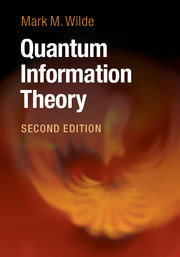Book contents
- Frontmatter
- Contents
- Preface to the Second Edition
- Preface to the First Edition
- How To Use This Book
- Part I Introduction
- Part II The Quantum Theory
- Part III Unit Quantum Protocols
- Part IV Tools of Quantum Shannon Theory
- 9 Distance Measures
- 10 Classical Information and Entropy
- 11 Quantum Information and Entropy
- 12 Quantum Entropy Inequalities and Recoverability
- 13 The Information of Quantum Channels
- 14 Classical Typicality
- 15 Quantum Typicality
- 16 The Packing Lemma
- 17 The Covering Lemma
- Part V Noiseless Quantum Shannon Theory
- Part VI Noisy Quantum Shannon Theory
- Appendix A Supplementary Results
- Appendix B Unique Linear Extension of a Quantum Physical Evolution
- References
- Index
14 - Classical Typicality
from Part IV - Tools of Quantum Shannon Theory
Published online by Cambridge University Press: 16 February 2017
- Frontmatter
- Contents
- Preface to the Second Edition
- Preface to the First Edition
- How To Use This Book
- Part I Introduction
- Part II The Quantum Theory
- Part III Unit Quantum Protocols
- Part IV Tools of Quantum Shannon Theory
- 9 Distance Measures
- 10 Classical Information and Entropy
- 11 Quantum Information and Entropy
- 12 Quantum Entropy Inequalities and Recoverability
- 13 The Information of Quantum Channels
- 14 Classical Typicality
- 15 Quantum Typicality
- 16 The Packing Lemma
- 17 The Covering Lemma
- Part V Noiseless Quantum Shannon Theory
- Part VI Noisy Quantum Shannon Theory
- Appendix A Supplementary Results
- Appendix B Unique Linear Extension of a Quantum Physical Evolution
- References
- Index
Summary
This chapter begins our first technical foray into the asymptotic theory of information. We start with the classical setting in an effort to build up our intuition of asymptotic behavior before delving into the asymptotic theory of quantum information.
The central concept of this chapter is the asymptotic equipartition property. The name of this property may sound somewhat technical at first, but it is merely an application of the law of large numbers to a sequence drawn independently and identically from a distribution pX(x) for some random variable X. The asymptotic equipartition property reveals that we can divide sequences into two classes when their length becomes large: those that are overwhelmingly likely to occur and those that are overwhelmingly likely not to occur. The sequences that are likely to occur are the typical sequences, and the ones that are not likely to occur are the atypical sequences. Additionally, the size of the set of typical sequences is exponentially smaller than the size of the set of all sequences whenever the random variable generating the sequences is not uniform. These properties are an example of a more general mathematical phenomenon known as “measure concentration,” in which a smooth function over a high-dimensional space or over a large number of random variables tends to concentrate around a constant value with high probability.
The asymptotic equipartition property immediately leads to the intuition behind Shannon's scheme for compressing classical information. The scheme first generates a realization of a random sequence and asks the question: Is the produced sequence typical or atypical? If it is typical, compress it. Otherwise, throw it away. The error probability of this compression scheme is non-zero for any fixed length of a sequence, but it vanishes in the asymptotic limit because the probability of the sequence being in the typical set converges to one, while the probability that it is in the atypical set converges to zero. This compression scheme has a straightforward generalization to the quantum setting, in which we wish to compress qubits instead of classical bits.
The bulk of this chapter is here to present the many technical details needed to make rigorous statements in the asymptotic theory of information. We begin with an example, follow with the formal definition of a typical sequence and a typical set, and prove the three important properties of a typical set.
- Type
- Chapter
- Information
- Quantum Information Theory , pp. 406 - 442Publisher: Cambridge University PressPrint publication year: 2017

